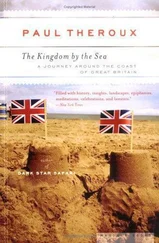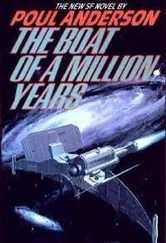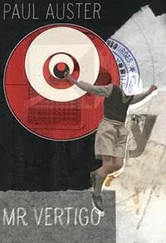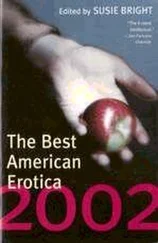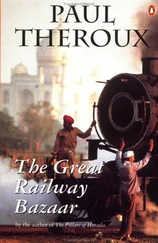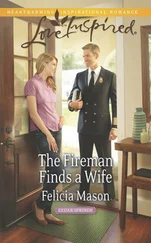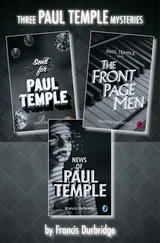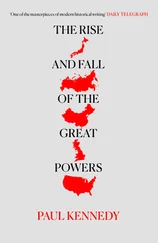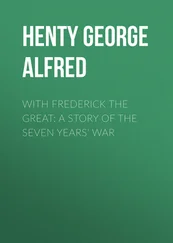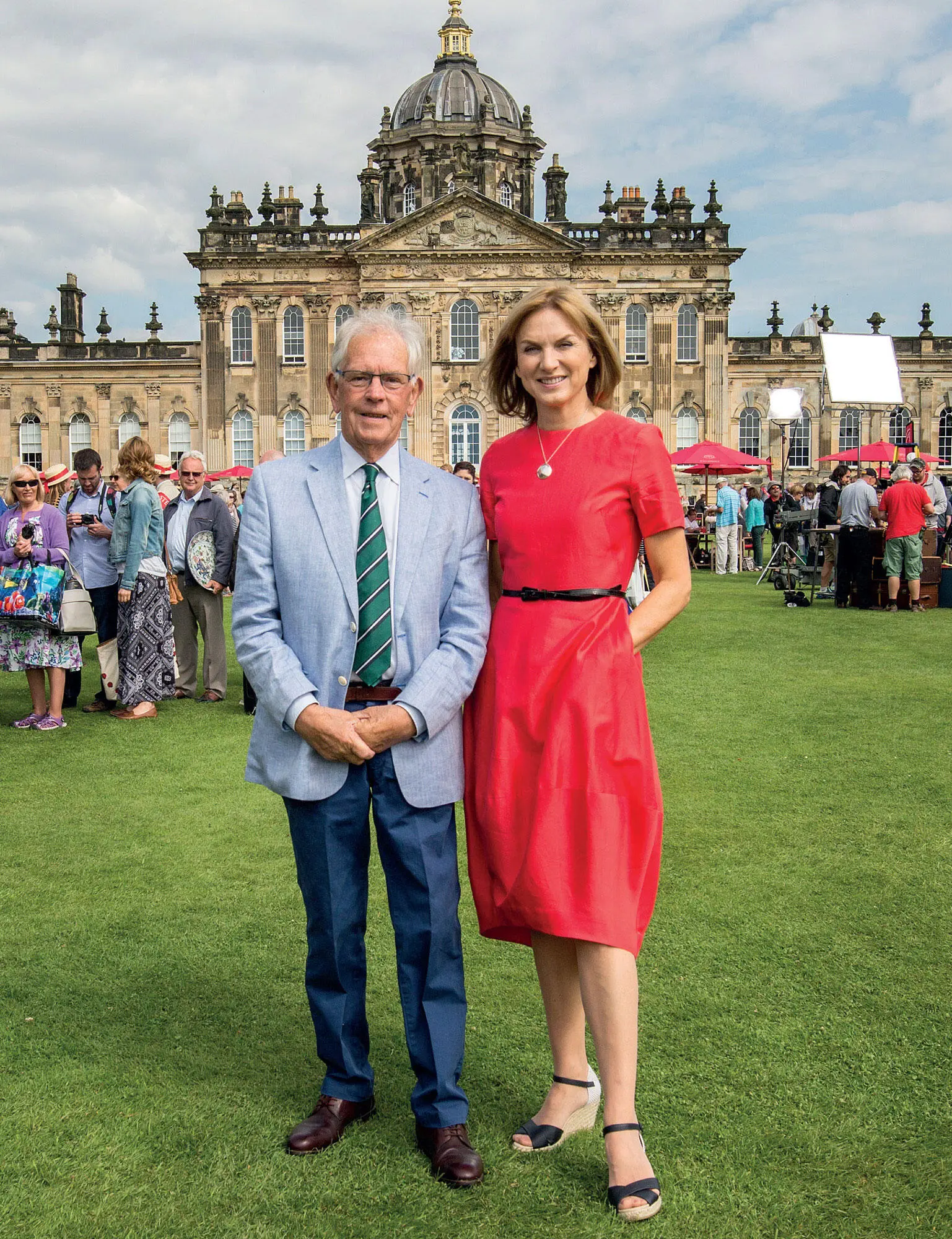
At Castle Howard in July 2017, to mark the Roadshow ’s 40th anniversary, a special guest was Bruce Parker, the show’s first presenter, seen here with Fiona Bruce.

Angela Rippon, the presenter for the Roadshow ’s second and third series, with Arthur Negus, the programme’s most famous expert in the early days.
On that May day in Hereford, the Roadshow quickly developed the winning formula, format, shape and style that it was broadly to follow for the next forty years. In a programme nominally about objects and their values, it soon became apparent that it could also be about their owners. As Hugh Scully once said: ‘ The programme is a cameo of the British character and its foibles, idiosyncrasies and eccentricities. It is the people that we most readily remember. They are the Antiques Roadshow. They give it the colour, charm, interest, anecdote and humour that delight us on Sunday evenings. We enjoy their happiness. We share their hopes. We feel their disappointments. ’
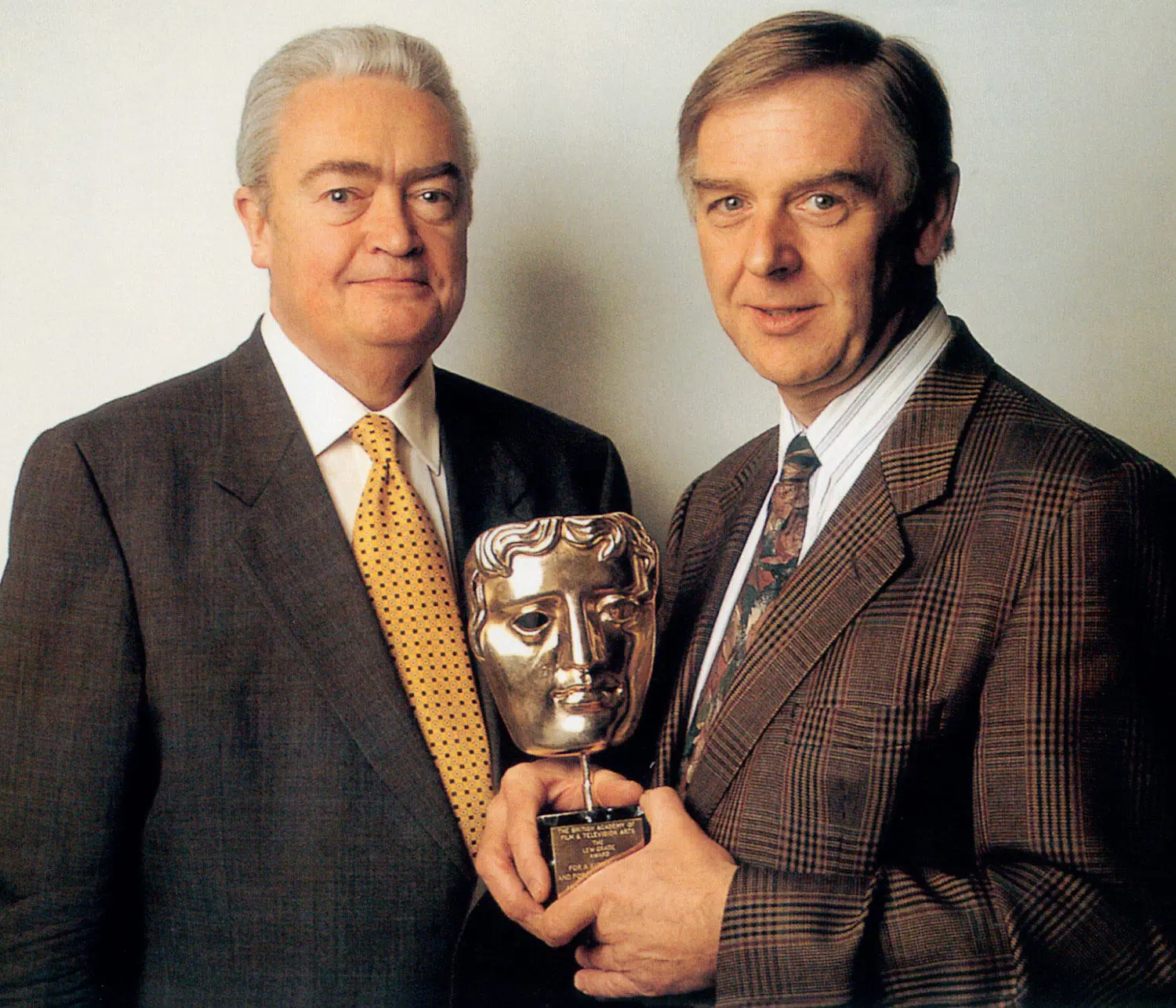
In 1996 the Roadshow was awarded a BAFTA, the Lew Grade Award for a Significant and Popular Television Programme. Hugh Scully and Christopher Lewis, Executive Producer at the time, show off the award.
Pilot programmes are rarely transmitted, but that first experimental show at Hereford went so well that it was included in the first series, once it had been commissioned. Between April and August 1978, the Roadshow visited Bedworth, Yeovil, Newbury, Northallerton, Buxton, Perth and Mold, setting a pattern, and a geographical spread, that has remained much the same ever since. As the Roadshow ’s popularity grew, so more filming locations were steadily added. By 1986 it had risen to twelve and by 1997 to twenty five, with a filming season that ran from 16 April 1997 to 19 March 1998. The next series started filming just over a month later, on 23 April 1998. More recently, the Roadshow ’s filming schedule has settled at twelve episodes each year, but with two programmes being made at each location. Also consistent has been the programme’s popularity and, forty years on from that day in Hereford, the Roadshow continues to attract on the day between 1,500 and 4,500 people keen to queue for hours for the chance to discuss their objects with the team of experts. For the first twenty or so years, the Roadshow was filmed from indoor locations such as sports halls and civic centres. In the late 1990s, the first outdoor locations appeared and, since then, the Roadshow ’s locations have generally been both outdoors and at places of architectural or historic interest.
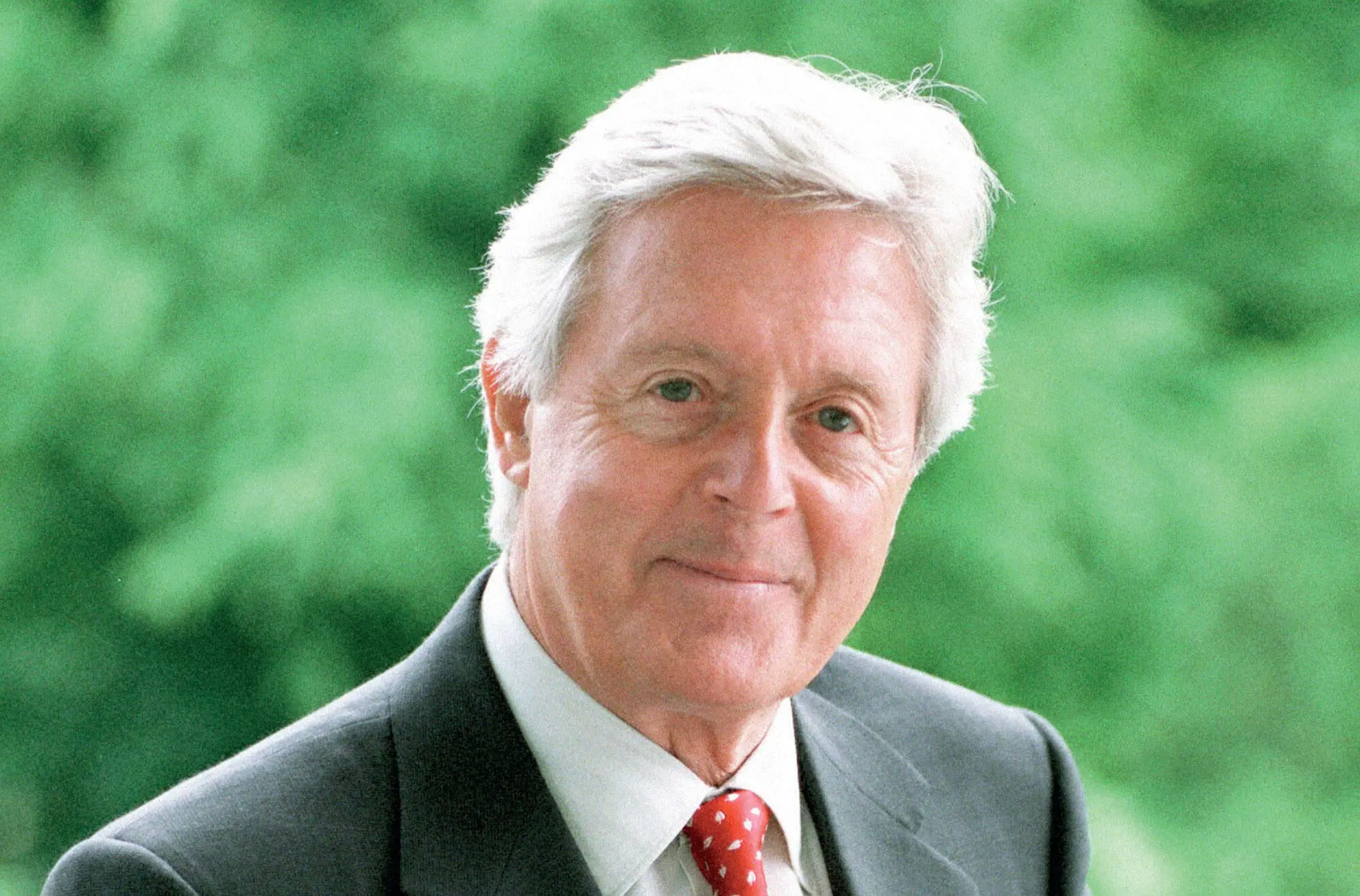
Michael Aspel fronted the Roadshow for eight years, hosting 200 episodes between the years 2000 and 2008.
A HARD-WORKING PROGRAMME
The Roadshow ’s core values have never changed. All objects, and their owners, are treated equally, regardless of the value. On the day, the team may assess and discuss between 7,000 and 12,000 objects, of which around fifty will be filmed and the experts will see everyone who comes in to the location before the entry deadline, which is usually 4.30pm. After that, everyone who has made it into the location before the deadline will be seen, and so the experts have a long day, usually starting at around 9am and finishing at any time between 5pm and 7pm, depending on the numbers present. The actual filming starts at 9.30am and finishes at 7pm. There can be no previewing of the objects, because there is no way of knowing in advance what the public are going to bring in. There is no ‘B’ team to deal with the less valuable or interesting objects. There is only one team, and it sees everything and everybody. When it comes to the filming, there are no rehearsals or run-throughs. Every item is filmed as live, but these live conversations will be edited into the items that are included in the transmitted programme. Finally, the Roadshow is not only a flagship programme for the BBC, but is also a major public event and a classic example of traditional public service broadcasting.
During its forty years, five people have presented the Roadshow . The first series was introduced by Bruce Parker, a familiar journalist and presenter for BBC South. For the second and third series he was replaced by Angela Rippon, then a nationally known news presenter, keen to develop her career in new directions. For series four, in 1981, Hugh Scully took the helm – a presenter much closer in both interests and experience to the world of art and antiques – and he was to remain the face of the Roadshow until 2000. Above all else, he appreciated the Roadshow ’s special quality: ‘ It is a programme that has maintained its freshness without having to make any drastic changes, purely because of the unpredictable nature of the event .’ Michael Aspel, who took over the presenter’s baton from Hugh, agreed. ‘ Having spent many years on programmes where every moment of the recording is planned, it is very exciting to approach a day on the Roadshow with absolutely no idea of what is going to happen. The people and their objects make the programme, and we react accordingly. ’ In 2008, Fiona Bruce took the helm, and she has been at the heart of the Roadshow ever since. Famous for her hands-on approach, Fiona also loves the programme’s particular quality: ‘ It’s all spontaneous and entirely unpredictable. ’

Fiona Bruce has been presenting the Roadshow since 2008.
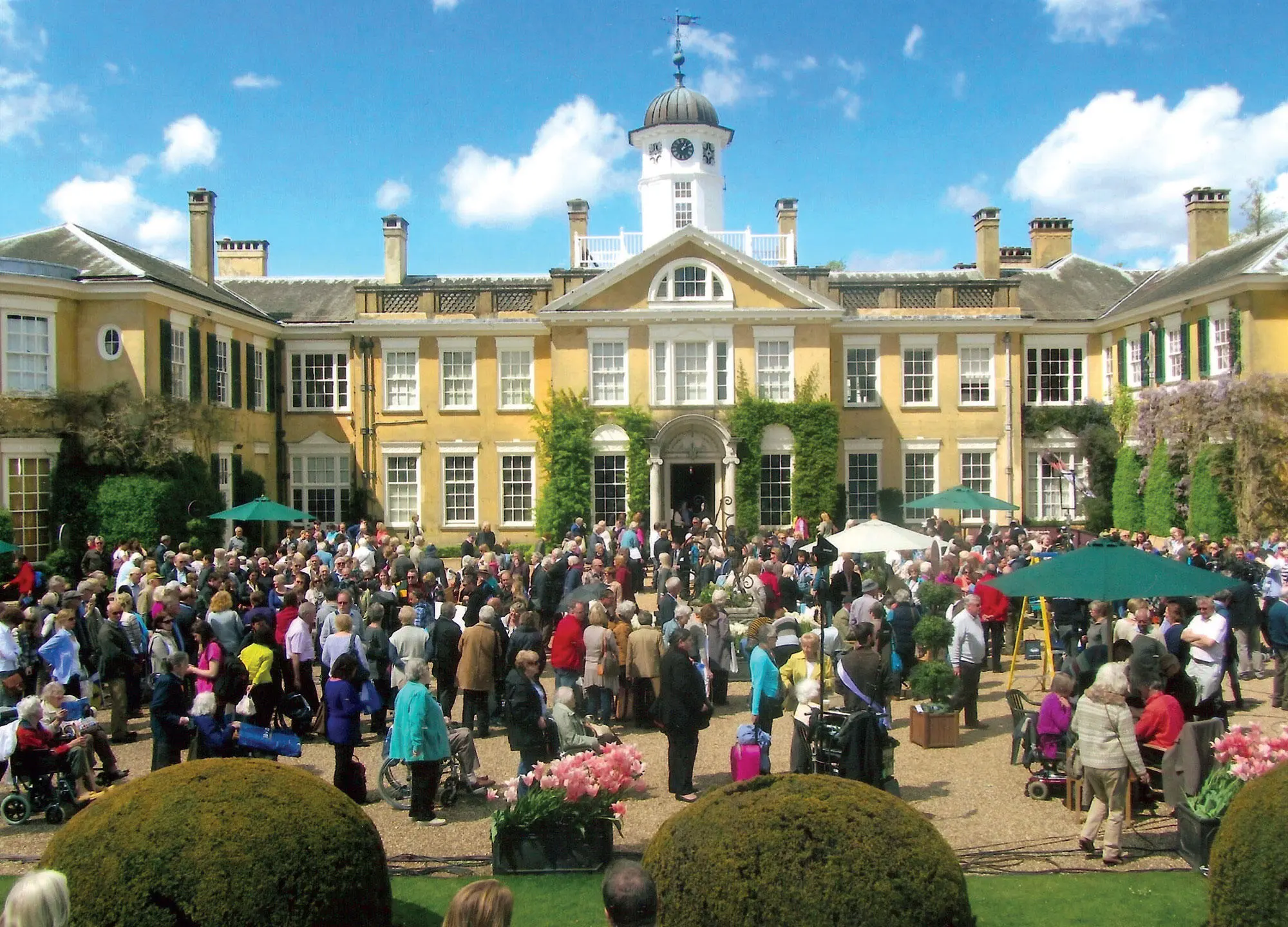
Outdoor Roadshows started in the late 1990s, and since then scenes like this have come to define the modern programme.
THE ATTRIBUTES OF A ROADSHOW EXPERT
From that small band of experts recruited for that pilot programme in Hereford has grown a remarkable team of knowledgeable and enthusiastic men and women drawn from all areas of the world of art and antiques. An expert on the Roadshow has to possess several attributes. Knowledge, and the ability to present that knowledge in an accessible manner is key, but they also have to be great team players and always ready to share their knowledge. They must have great patience and be willing to talk for hours to owners about their objects, not all of which will be very exciting. In short, they should like people and enjoy engaging with them. They must remain friendly and enthusiastic throughout a long and sometime challenging day, often with very few breaks. Most importantly, they have to be ambassadors for the programme and the BBC. At most Roadshow s there will be a team of twenty to twenty-five experts on duty, covering all the disciplines, but the make-up of the team will vary from show to show.
Читать дальше







